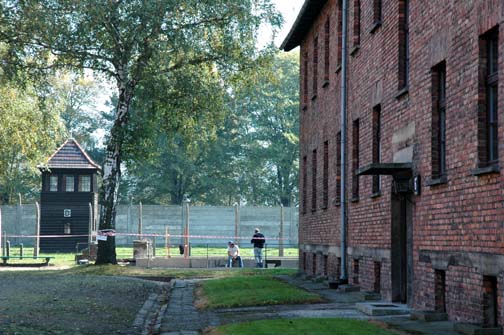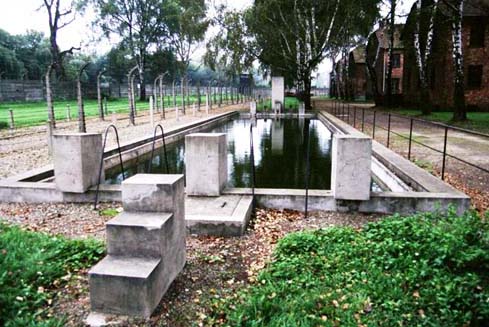Swimming Pool at Auschwitz I
 Swimming Pool Repair
at Auschwitz, October 2005
Swimming Pool Repair
at Auschwitz, October 2005
The photo above is an early morning shot
of Block 6, one of the brick barracks buildings in the Auschwitz
main camp. In the background, you can see construction workers
repairing the swimming pool.
The photo below shows what the swimming
pool looked like in 1996 before preservation work began. The
high diving board is at the far end in the background of the
photo. The diving board itself is now gone.
 Swimming pool at Auschwitz
main camp, 1996
Swimming pool at Auschwitz
main camp, 1996
In the background, on the left side of
the photo above, you can see the wall around the camp, and on
the right, you can see Blocks 7 and 8 in the camp.
When I visited Auschwitz in 1998, I asked
to see the swimming pool, but I was told that it was not on the
tour. My tour guide told me that there were two swimming pools,
one for the prisoners and one for the SS men, but she would not
show me either pool. When I returned in 2005, the swimming pool
for the prisoners was still not included on the tour, but I found
it myself as I wandered around on my own in the early morning.
The swimming pool is now called a water
reservoir on a sign board that was erected some time after my
visit to Auschwitz in October 2005. The words on the sign board
are in Polish, English and Hebrew; the sign reads as follows:
"Fire brigade reservoir built in the form of a swimming
pool, probably in early 1944."
Old black and white photos of the swimming
pool can be seen on this web site.
There is also a water reservoir at the
Mauthausen
concentration camp which is built in the form of a swimming
pool. On my 1998 tour of Auschwitz Birkenau, I saw a pool of
water along the main road in the Birkenau camp. My tour guide
told me that this was a water reservoir; this pool was gone when
I visited Birkenau in 2005.
Barbara Cherish, the daughter of Arthur
Liebehenschel, wrote a book which was published in 2009,
entitled "My father, the Auschwitz commandant." In
her book, Barbara credits her father with building a swimming
pool for the use of the prisoners. Liebehenschel was the Commandant
of the Auschwitz main camp for five months, beginning on December
1, 1943. Liebehenschel is credited with other improvements at
Auschwitz I, including the tearing down of the standing cells
in Block 11.
In the Epilogue of the book entitled
"Death Dealer," which was first published in 1992 as
the autobiography of Auschwitz Kommandant Rudolf Höss, the
editor of the book, Steven Paskuly wrote the following:
When Höss was promoted to Berlin,
his replacement, Kommandant Arthur Liebehenschel, was put in
charge of just the Auschwitz camp... [...] He had the water trough
near Blocks 7 and 8 converted into a swimming pool for Kapos
and prisoners who worked well.
This page was last updated on January
17, 2010
|